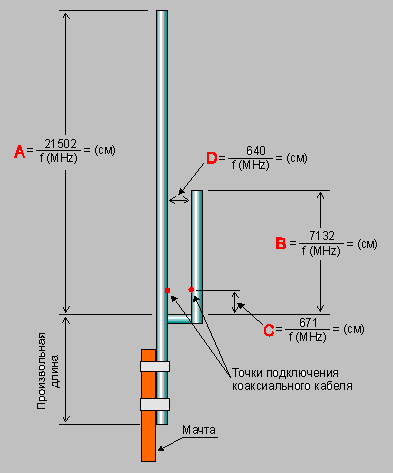Particularly simple way of eating a half-wave vertical antenna is that high resistance to the lower end of the radiator is connected closed quarter-wave line "B" and the length of the searched impedance corresponding to the characteristic impedance of the power cable. Since the length of L/4 line resistance changes from tens of thousands of Ohms at the point of the lower end of the radiator (high voltage) to the zero point of the circuit matching lines (low voltage), thus you can agree with antenna coaxial cable and ribbon cable УSW with any wave resistance, as well as two-wire power line with an air-insulated a characteristic impedance of 600 Ohms.

The advantage of this method of feeding the antenna is that the lower closed end L/4 matching lines "B" can be grounded and, in addition, the antenna can simultaneously serve a good lightning rod.
Optimum matching of the supply line to the antenna (size "C") is searched as follows: the emitter (in the area of the top point matching ribbon cable) connects a neon bulb and the connection point of the power cable is moved until, until there comes the brightest light up the bulb.
It is recommended that a quarter-wave matching line "B" to do slightly longer than the calculated length and use a movable contact bridge. Then excite the antenna with the help of a nearby auxiliary antenna connected to the transmitter. In this case, a quarter-wave line is not connected supply line and changing the location of the closing jumpers achieve maximum glow neon light, included in the connection point of the lower end of the radiator with a quarter-wave matching line. Thus, the emitter and matching line are tuned in resonance with an operating frequency. Then auxiliary disconnect the antenna from the transmitter and the vertical emitter is connected to line power, the coordination of which is described above. Configured this way, the emitter is a great antenna for establishing long-haul communication. The antenna has a circular radiation pattern, provided that it is mounted at a sufficiently high altitude.
Literature
Publication: www.cxem.net






